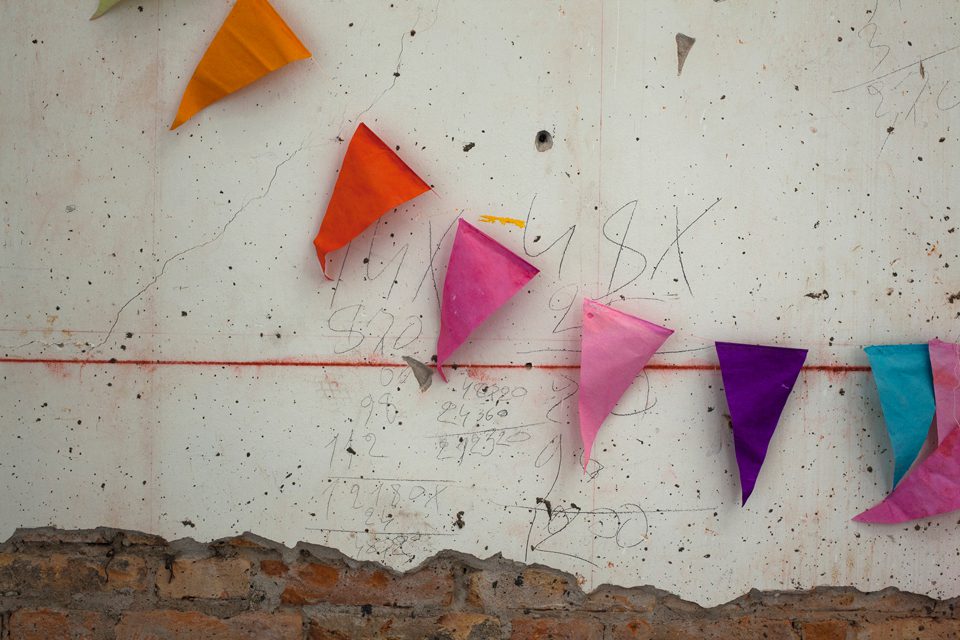The Argentinian-born artist Amalia Pica’s first major museum show explores her vast oeuvre, highlighting her ongoing preoccupation with modes of communication.
Modern technology and digital communications are transforming our worlds. With the prospect of FaceTime with someone on the other side of the planet at the touch of a screen, and the concentration of breaking news stories into 140 characters, our avenues and opportunities for communication are more varied and further reaching than ever before. The result is an internationalised artistic community, a blurring of the boundaries of language and technology, and myriad opportunities for the artist to comment on this ever-changing and evolving landscape and humanity’s place within it.
Amalia Pica’s eponymous exhibition at the Museum of Contemporary Art Chicago is her first major museum show and a welcome introduction of the multi-layered work of the Argentinian-born artist to a wider audience. Focusing on communication and the representation of language, as well as history, politics and the creative (and often comic) potential of our social spaces, Pica has established an oeuvre that defies categorisation and raises interesting queries in the mind of the viewer.
Having studied in Buenos Aires and Amsterdam, Pica has mounted solo exhibitions at Kunst Halle Sankt Gallen, Marc Foxx Gallery and Chisenhale Gallery, as well as participating in numerous group exhibitions and the Venice Biennale. Her best-known early work, Hora Catedra (directly translated as School Period), engages her fascination with the lessons and tropes of childhood, and how they irrevocably stay with us through adult life. The 2002 site-specific installation took place at the House of Tucuman which, as the building where Argentina’s independence was declared in 1816, holds an important place in the hearts of her fellow countrymen. Pica’s irreverent work saw the monument bathed in a bright yellow light in reference to the misconception, on the part of many Argentineans, that this national monument is yellow due to its depiction as such in school textbooks. While, in reality, the House of Tucuman is a bright white, colonial style building, its perception as yellow is a legacy of Argentina’s classroom teaching: something that Pica’s work realises, engaging with her preoccupation with the idea of childhood and how it forms our ideas of things much later in life. Included in Amalia Pica’s accompanying publication (itself yellow in recognition of this early work), Hora Catedra is a precursor to the artist’s later, darker explorations of the role of government in controlling and manipulating the minds of its citizens. Co-curator (alongside Pamela Alper, Associate Curator at MCA Chicago, and João Ribas, Curator at MIT List Visual Art Center) Julie Rodrigues Widholm acknowledges the importance of this piece as a starting point, although it can’t be represented in the exhibition: “Pica’s references to childhood stem from an interest in how our imaginations are shaped from a very early age. One wonders if it is possible to encounter an artwork with the perspective – for example, without fear or prejudices – of a child; to re-train our eyes in how to see the world around us.”
Having been awarded a CIFO grant (from the Cisneros Fontanals Art Foundation), and as a finalist for the Pinchuk Foundation’s Future Generation Art Prize, Pica has been touted as one of the most promising artists of her generation but, until now, her work has not received significant attention from major museums. Rodrigues Widholm believes that this is “the perfect time to introduce her work to an American audience in a very substantial way, with a survey exhibition and monographic publication,” engaging as it does with aspects of human communication through both verbal and non-verbal means. “Her playful and poetic means of thinking about language, communication and human connections feel very germane to our increasingly digital lifestyles.” Pica is an artist who is becoming more relevant to the way we live our lives.
Her works use a range of materials from found objects to photography as well as live performers. They address themes ranging from freedom of speech and the awkwardness and often contrived nature of social situations to language and its potential for nonsense, related puns and communicative humour. Strangers (2008) is a live performance pushing boundaries for its participants simply in the discomfort of engaging in an act of collaboration with a fellow stranger, but without the ease of small talk and ice breakers. Sporadically, for hours at a time throughout the exhibition’s run, two strangers will hold a length of bunting, but at a distance from which they are unable to engage with each other verbally. Referencing the social spaces that we are often thrown into without knowing of other participants beforehand, Rodrigues Widholm says: “The bunting suggests a party or communal gathering, and Pica plays with the idea of distance and proximity as it relates to communication.” Bunting and the paraphernalia of the party continues in another work, Stabile (With Confetti), showing the aftermath of the party or celebration. Thousands of pieces of confetti are taped to the floor, suggesting “these social situations when we come together with strangers but still have to overcome the awkwardness of meeting someone new.” More pertinently, Rodrigues Wildholm alludes to the experience of “having a deep, yet fleeting, conversation at a party then never seeing someone again,” and the prospect of relationships temporarily formed and lost among life’s moments of randomness.
On a more serious and politically charged note, Pica has, in the past, referenced her childhood growing up in Argentina during the country’s “Dirty War” with its thousands of “disappeared” victims. It is as a result of this legacy that she places such a high value on the importance of free speech and political will. Venn Diagrams (Under the Spotlight) (2011) highlights the absurdity of such an extreme pursuit of government control in reminding viewers of the banning of modern mathematics from the school curriculum, while her attention moves to Afghanistan for Stage (as seen on Afghan Star) (2011), displayed in the exhibition. Considering “the relationship between free speech and democracy, or the lack thereof, in certain countries Pica, recreated the stage from the Afghani television version of American Idol, which for many Afghans was their first taste of democracy when voting for their favorite singer.” Solitary and uninhabited, the star-shaped stage is both desolate and inviting; it gives the impression of the calm after the storm when the audience and the performers have retired, and almost encourages the viewer to mount it for their own moment in the spotlight. Rodrigues Wildholm argues that “the empty stage makes us think about who has the right to perform and why.” It engages not only with concepts of freedom of speech and democratic voting processes, but also with the cult of celebrity, and the absurdity of how the vacuous process of voting in a reality television show should have preceded free and fair political elections.
The nomadic sculpture I am Tower of Hamlets, as I am in Tower of Hamlets, just like a lot of other people are (2011) is a pink marble sculpture of a popular Argentine house plant, which spent a year travelling through the houses of Pica’s neighbours in her new East London home. It ties together her roots with her current life as an artist living and working in London, and will subsequently be passed around Chicago households for the exhibition. In this way, it connects Pica’s homeland, her adopted home and the site of her new major exhibition, and creates a coherent narrative around the roles of the artist and the internationalist in this day and age.
Perhaps the most important element of Pica’s work, however, is her exploration of language and how languages that have been created in both organic and more contrived circumstances (and which are viewed as an important and dominant signifier of civilisation) can be turned into something nonsensical, almost silly. In Babble, Blabber, Chatter, Gibber, Jabber, Patter, Prattle, Rattle, Yammer, Yada yada yada (2010), Pica illustrates this white noise of a sentence using semaphore flags, thereby turning a cultivated, inherently useful language form on its head by making its act of communication completely useless. Although this can be seen to reference Pica’s engagement with the importance of free speech by highlighting how easily language can be manipulated, Rodrigues Widholm sees this piece as “related to issues of translation,” but with the opposite of this implication’s expected effects. Instead of something meaningful being lost in translation it becomes, conversely, nonsense which takes on the tropes of being meaningful.
It’s clear that Pica delights in the potential of words for play. The Catachresis (2011) series is an existing body of work to which Pica has added new pieces for the exhibition. The works juxtapose “found objects that play with catachresis, or the application of terms that apply to things that don’t have their own word, for example the teeth of a comb, leg of a chair, tongue of a shoe or elbow of a pipe.” The pieces are an amalgamation of different body parts, all taken from inanimate objects, so a bottle neck will totter above a table leg, creating a lighthearted Frankenstein’s monster of word associations.
The Catachresis pieces further the childlike confusion of Pica’s early enactment, Hora Catedra (2002), as well as exploring the flexibilities of language and its possibly comical consequences. In a way it represents the coming together of Pica’s many themes, and provides the most comprehensive idea of what she is about as an artist. Catachresis also established the importance of humour in her work, and this is something that keeps it constantly fresh, engaging and approachable. Rodrigues Widholm furthers that “Pica’s work has a self-deprecating humour that is endearing in its honesty and humility. She reminds us of the foibles of the human condition and the great lengths to which we go to communicate and connect with one another.”
Working closely with Pica herself in selecting and displaying the works, the curators were faced with a challenge in her remarkably diverse oeuvre: “We wanted to highlight the variety of approaches, materials and themes that have been addressed in her work over the past 10 years while ensuring that the pieces we chose would look good in our galleries in order to create a compelling and logical dialogue with each other across the spaces throughout the exhibition.”
As a mid-career review, and an introduction of Pica to a wider audience, the curators engaged with the body of work as an ongoing process in comparison to the usual mounting of a retrospective. Rodrigues Widholm says: “We view this exhibition as a survey of the first 10 years of her work.” She argues that its main purpose is “as an introduction to an American audience that is not already familiar with who she is and her work.” Less “reflective and comprehensive” than a retrospective, Amalia Pica is a launch pad for the next stage of the artist’s career, and shows pieces and series that are constantly evolving and growing.”
In including performance, sculpture and installation, the show illustrates the breadth of Pica’s oeuvre not only thematically but physically, and challenges the curators to make a coherent narrative through the exhibition. Rodrigues Widholm acknowledges: “There are certain conversations between works that we wanted to bring to the foreground and that, in many ways, make it easy for our visitors to make formal and conceptual connections between the works.” The curators’ approach was to combine the media in order to highlight the themes: “We consciously have a mixture of all media in each of the galleries to demonstrate how Pica’s ideas are fluidly expressed among them. It’s quite customary today to find artists who work in sculpture, installation and video because they choose the medium that best suits the concept of the work.”
In working with seemingly simple materials and found objects, and turning them into unexpected works of art, Pica displays “a keen sensitivity to materials, an intellectual rigour, and purposeful editing of objects to be able to use such familiar materials so evocatively. Nothing can be extraneous in her work.” To this end, Amalia Pica is both a fantastic introduction to, and a greater exploration of, the talent and preoccupations of an exciting artist.
Amalia Pica is showing at the Museum of Contemporary Art Chicago in association with MIT List Visual Art Centre from 27 April to 11 August 2013. For further information, please visit www.mcachicago.org.
Ruby Beesley





